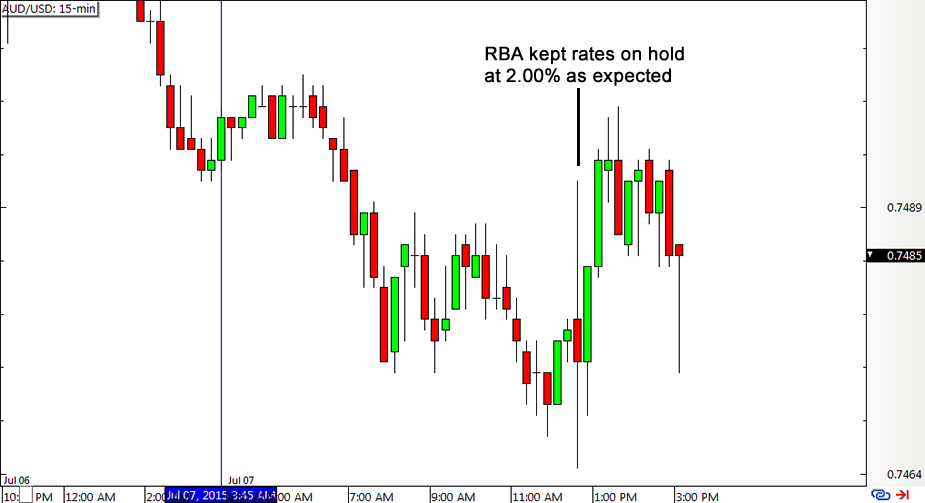As expected, the Reserve Bank of Australia (RBA) decided to keep interest rates on hold at 2.00% in this week’s monetary policy announcement. These takeaways from their official statement might contain some clues about potential rate cuts and the Aussie’s forex price action.
1. Downbeat economic assessment
If you’ve read my latest Monthly Economic Recap on Australia, then it shouldn’t come off as a surprise that RBA head honcho Glenn Stevens pointed out that growth in Australia has been below its long-term average. Might as well call it the Land Down Underperforming! He also mentioned that unemployment remains elevated and that the economy could continue to operate with a degree of spare capacity for quite some time.
Because of that, Stevens said that monetary policy needs to stay accommodative, as the low interest rate environment could keep lending and spending supported. He also doesn’t see inflation picking up anytime soon, mostly due to the slow growth in labor costs.
2. Not too worried about risks from Greece and China
There’s no denying that Greece’s never-ending debt drama and China’s stock market fiasco have been bringing a lot of uncertainty to the table and keeping policymakers on their toes. As for the folks over at the RBA, Stevens clarified that they’re not yet losing sleep over the fluctuations in the financial markets stemming from these issues since “long-term borrowing rates for most sovereigns and creditworthy private borrowers remain remarkably low.”
In other words, Stevens is saying that there haven’t been any glaring signs of financial market trouble so far. He mentioned that other central banks are maintaining their easing biases, which suggests that the global economy might still have a bit of a buffer in case the situation worsens.
3. Concerns about falling commodity prices
What RBA policymakers seem more worried about is the continuous decline in commodity prices. After all, Australia relies heavily on its mining industry and raw material exports, and falling prices mean falling revenues. Stevens noted that some key commodity prices are much lower than a year ago and that this is weighing on the country’s trade activity.
Iron ore prices are currently trading at record lows, thanks to a surge in supply coupled with a drop in demand. The downturn in China’s steel industry has been the main culprit for the decline in iron ore export volumes from Australia, leading to losses for small mining companies in the country.
4. Further AUD depreciation both likely and necessary
As always, Stevens grabbed the opportunity to jawbone the Australian dollar before dropping the mic. He said that, even though the Aussie has lost value to the U.S. dollar over the past year, the currency has yet to post larger declines against its other forex rivals. He emphasized that “further depreciation seems both likely and necessary” in order to keep inflation stable against a backdrop of falling commodity prices.
The Aussie’s reaction to the RBA statement? Ehh, I’ve heard it all before. In fact, AUD/USD even gained a few pips after the actual announcement, as some forex traders probably exited their short forex positions upon finding out that interest rates weren’t cut.
Apart from that, some Aussie bears might’ve also scampered away when they realized that the July RBA announcement barely contained any changes from the June statement, despite the global economic risks that have emerged in the past few weeks. Let’s wait and see if the minutes of their meeting show anything new!
Recommended Content
Editors’ Picks
EUR/USD edges lower toward 1.0700 post-US PCE

EUR/USD stays under modest bearish pressure but manages to hold above 1.0700 in the American session on Friday. The US Dollar (USD) gathers strength against its rivals after the stronger-than-forecast PCE inflation data, not allowing the pair to gain traction.
GBP/USD retreats to 1.2500 on renewed USD strength

GBP/USD lost its traction and turned negative on the day near 1.2500. Following the stronger-than-expected PCE inflation readings from the US, the USD stays resilient and makes it difficult for the pair to gather recovery momentum.
Gold struggles to hold above $2,350 following US inflation

Gold turned south and declined toward $2,340, erasing a large portion of its daily gains, as the USD benefited from PCE inflation data. The benchmark 10-year US yield, however, stays in negative territory and helps XAU/USD limit its losses.
Bitcoin Weekly Forecast: BTC’s next breakout could propel it to $80,000 Premium

Bitcoin’s recent price consolidation could be nearing its end as technical indicators and on-chain metrics suggest a potential upward breakout. However, this move would not be straightforward and could punish impatient investors.
Week ahead – Hawkish risk as Fed and NFP on tap, Eurozone data eyed too

Fed meets on Wednesday as US inflation stays elevated. Will Friday’s jobs report bring relief or more angst for the markets? Eurozone flash GDP and CPI numbers in focus for the Euro.
